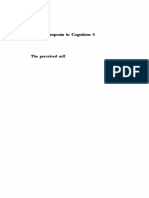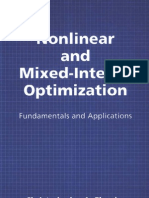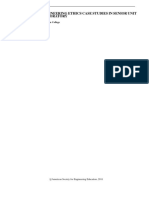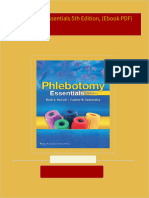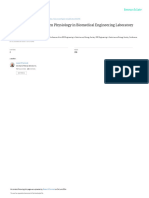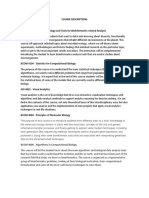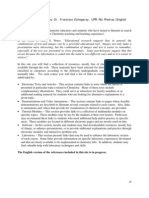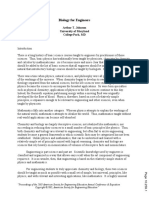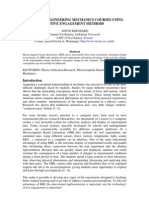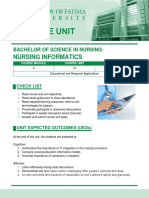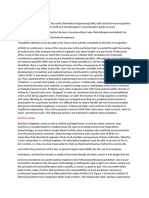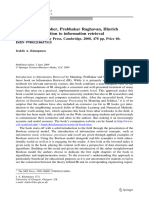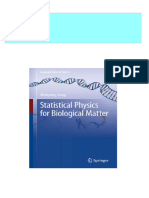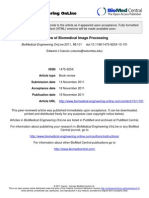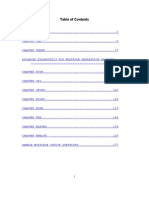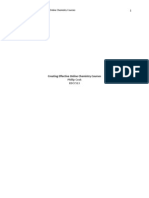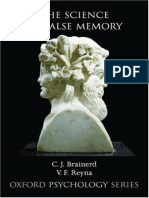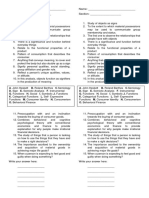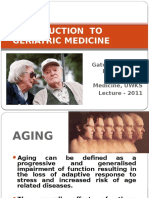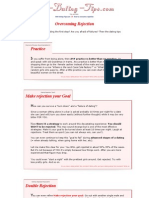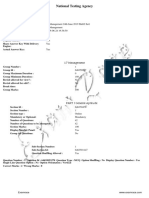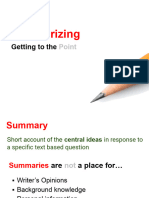Biomechnics
Biomechnics
Uploaded by
ka.puro.k.i.v.in.ceCopyright:
Available Formats
Biomechnics
Biomechnics
Uploaded by
ka.puro.k.i.v.in.ceOriginal Title
Copyright
Available Formats
Share this document
Did you find this document useful?
Is this content inappropriate?
Copyright:
Available Formats
Biomechnics
Biomechnics
Uploaded by
ka.puro.k.i.v.in.ceCopyright:
Available Formats
X FUNDAMENTALS OF BIOMECHANICS
part opener provides a concise summary of of how the biomechanical principles can be
the importance and content of that section qualitatively applied to improve human
of text. The text builds from familiar ana- movement in a variety of professions. No
tomical knowledge, to new biomechanical other text provides as many or as thorough
principles and their application. guided examples of applying biomechani-
This book has several features that are cal principles in actual human movement
designed to help students link personal ex- situations. These application chapters also
perience to biomechanical concepts and provide discussion questions so that students
that illustrate the application of biome- and instructors can extend the discussion
chanics principles. First, nine general prin- and debate on professional practice using
ciples of biomechanics are proposed and specific examples.
developed throughout the text. These prin- There are also features that make it easy
ciples are the application link for the bio- for students to follow the material and
mechanical concepts used to improve study for examinations. Extensive use of
movement or reduce injury risk. Some texts graphs, photographs, and illustrations are
have application chapters at the end of the incorporated throughout. Aside from visual
book, but an application approach and ex- appeal, these figures illustrate important
amples are built in throughout Funda- points and relationships between biome-
mentals of Biomechanics. Second, there are chanical variables and performance. The
activity boxes that provide opportunities for book provides an extensive glossary of key
students to see and feel the biomechanical terms and biomechanics research terminolo-
variables discussed. Third, there are practi- gy so that students can read original biome-
cal application boxes that highlight the appli- chanical research. Each chapter provides a
cations of biomechanics in improving summary, extensive citations of important
movement and in treating and preventing biomechanical research, and suggested read-
injury. Fourth, the interdisciplinary issues ings. The chapters in Parts I, II, and III con-
boxes show how biomechanics is integrated clude with review questions for student study
with other sport sciences in addressing hu- and review. The lists of web links offer stu-
man movement problems. Fifth, all chap- dents the internet addresses of significant
ters have associated lab activities (located at websites and professional organizations.
the end of the book, after the index) that use I hope that you master the fundamen-
simple movements and measurements to tals of biomechanics, integrate biomechan-
explore concepts and principles. These lab ics into your professional practice, and are
activities do not require expensive lab challenged to continuously update your
equipment, large blocks of time, or dedicat- biomechanical toolbox. Some of you will
ed lab space. Finally, Part IV (chapters 9 find advanced study and a career in biome-
through 12) provides real-life case studies chanics exciting opportunities.
You might also like
- CHCECE054 Assessment Task 3 Placement TaskDocument7 pagesCHCECE054 Assessment Task 3 Placement TaskSherin Subhan100% (2)
- The Perceived Self Ecological and Interpersonal Sources of Self Knowledge Emory Symposia in Cognition PDFDocument331 pagesThe Perceived Self Ecological and Interpersonal Sources of Self Knowledge Emory Symposia in Cognition PDFtsiky100% (1)
- Moran Safiro Solucionario Inglés (5 Edicion)Document847 pagesMoran Safiro Solucionario Inglés (5 Edicion)Raul75% (4)
- Critique PaperDocument4 pagesCritique PaperJoshuel Ibasco50% (6)
- Bruce, E.N.-biomedical Signal Processing&Signal ModelingDocument534 pagesBruce, E.N.-biomedical Signal Processing&Signal ModelingReza Rad75% (4)
- 0195100565Document475 pages0195100565talebramli100% (1)
- BiomechnicsDocument1 pageBiomechnicska.puro.k.i.v.in.ceNo ratings yet
- Work in Progress: Hands-On Biomechanics Lab For Undergraduate UniversitiesDocument7 pagesWork in Progress: Hands-On Biomechanics Lab For Undergraduate Universitiesعباس حماديNo ratings yet
- Full download Experimental Methods in Biomechanics John H. Challis pdf docxDocument62 pagesFull download Experimental Methods in Biomechanics John H. Challis pdf docxiheparehile100% (3)
- Ac 2011-2265: Engineering Ethics Case Studies in Senior Unit Operations LaboratoryDocument7 pagesAc 2011-2265: Engineering Ethics Case Studies in Senior Unit Operations LaboratoryAMIR I.SNo ratings yet
- Biochemistry Essential ConceptsDocument364 pagesBiochemistry Essential ConceptsBalraj MallekediNo ratings yet
- Mathematical Modelling in Systems Biology An IntroDocument397 pagesMathematical Modelling in Systems Biology An IntroCamiloNo ratings yet
- Instant Access to Pericyclic Chemistry Orbital Mechanisms and Stereochemistry 1st Edition - eBook PDF ebook Full ChaptersDocument41 pagesInstant Access to Pericyclic Chemistry Orbital Mechanisms and Stereochemistry 1st Edition - eBook PDF ebook Full Chaptersmotezshuana100% (2)
- Kurt Varmuza-Chemometrics in Practical Applications-Intech (2012)Document338 pagesKurt Varmuza-Chemometrics in Practical Applications-Intech (2012)David Santiago100% (1)
- Scaling Chemical Processes - Practical Guides in Chemical EngineeringDocument2 pagesScaling Chemical Processes - Practical Guides in Chemical EngineeringVikin JainNo ratings yet
- A Web Based Case Study For The Chemical Engineering Capstone CourseDocument9 pagesA Web Based Case Study For The Chemical Engineering Capstone CourseMikael SalamancaNo ratings yet
- Control Theory TutorialDocument112 pagesControl Theory TutorialTuan VuNo ratings yet
- Applied Medical Image Processing A Basic Course byDocument6 pagesApplied Medical Image Processing A Basic Course bySamuel Gill ChristinNo ratings yet
- Download Full Phlebotomy Essentials 5th Edition, (Ebook PDF) PDF All ChaptersDocument51 pagesDownload Full Phlebotomy Essentials 5th Edition, (Ebook PDF) PDF All Chaptersphebepazarx1100% (2)
- A New Innovative Lab Course For Biomedical Engineering Students - Clinical - Application - Driven - Physiology - in - BiomedicDocument3 pagesA New Innovative Lab Course For Biomedical Engineering Students - Clinical - Application - Driven - Physiology - in - BiomedicGeneration GenerationNo ratings yet
- Complete Download Algebra: Form and Function, 2nd Edition (eBook PDF) PDF All ChaptersDocument41 pagesComplete Download Algebra: Form and Function, 2nd Edition (eBook PDF) PDF All Chaptersmucanselema100% (2)
- Mathematical Modeling in Systems BiologyDocument406 pagesMathematical Modeling in Systems BiologyEduardo SvendbladNo ratings yet
- Biochemical Education - July 1988 - Learmonth - Multiple Applications For Computers in Biochemical EducationDocument4 pagesBiochemical Education - July 1988 - Learmonth - Multiple Applications For Computers in Biochemical EducationpraizdodoNo ratings yet
- Therapeutic Modalities for Musculoskeletal Injuries 4th Edition, with Audio/Video (Ebook PDF) download pdfDocument51 pagesTherapeutic Modalities for Musculoskeletal Injuries 4th Edition, with Audio/Video (Ebook PDF) download pdfshylaliaraxz100% (1)
- A Biomedical Microsystems Course For Electrical EngineersDocument8 pagesA Biomedical Microsystems Course For Electrical EngineersHakemNo ratings yet
- Full (Ebook PDF) Absolute, Ultimate Guide To Principles of Biochemistry Study Guide and Solutions Manual 7th Edition Ebook All ChaptersDocument51 pagesFull (Ebook PDF) Absolute, Ultimate Guide To Principles of Biochemistry Study Guide and Solutions Manual 7th Edition Ebook All Chaptersriauzyenol12100% (8)
- Principles of Econometrics: A Modern Approach Using Eviews by Sankar Kumar BhaumikDocument4 pagesPrinciples of Econometrics: A Modern Approach Using Eviews by Sankar Kumar Bhaumikmrindia2110No ratings yet
- Tanzanian A Level Chemistry SyllabusDocument5 pagesTanzanian A Level Chemistry SyllabusSamuel Ernest67% (3)
- Prescott, Harley, and Klein's Microbiology, 7/e Willey/Sherwood/WoolvertonDocument4 pagesPrescott, Harley, and Klein's Microbiology, 7/e Willey/Sherwood/WoolvertonHoi NguyenNo ratings yet
- Download Complete Elasticity: theory, applications, and numerics Fourth Edition Sadd PDF for All ChaptersDocument47 pagesDownload Complete Elasticity: theory, applications, and numerics Fourth Edition Sadd PDF for All Chaptersyanaiesunge100% (1)
- Bme 531aDocument4 pagesBme 531aSAMPATH ANo ratings yet
- Course Descriptions: BCOM 4006 - Algorithms in Computational BiologyDocument3 pagesCourse Descriptions: BCOM 4006 - Algorithms in Computational BiologyDavid GuevaraNo ratings yet
- Bioreactors: Catalan (Cat) Francesc - Godia@uab - Cat Francesc Gòdia CasablancasDocument4 pagesBioreactors: Catalan (Cat) Francesc - Godia@uab - Cat Francesc Gòdia CasablancasNeils ArenósNo ratings yet
- ASEE E 3 Examples Final PDFDocument12 pagesASEE E 3 Examples Final PDFSRINIVAS KALYANNo ratings yet
- ChemistryDocument31 pagesChemistryjochiman100% (1)
- PDF Continuum Mechanics Modeling of Material Behavior 1st Edition Martin H. Sadd downloadDocument81 pagesPDF Continuum Mechanics Modeling of Material Behavior 1st Edition Martin H. Sadd downloadboxiehuganlfNo ratings yet
- Biology For EngineersDocument7 pagesBiology For EngineersSaket SayankarNo ratings yet
- Exercises and Problems in Mathematical Methods of Physics Giampaolo Cicogna Download PDFDocument62 pagesExercises and Problems in Mathematical Methods of Physics Giampaolo Cicogna Download PDFehdfraleva100% (3)
- Complete Download Experimental Methods in Biomechanics John H. Challis PDF All ChaptersDocument55 pagesComplete Download Experimental Methods in Biomechanics John H. Challis PDF All Chaptersaeronfusha9y100% (2)
- Biochemistry. ISBN 1429229365, 978-1429229364Document23 pagesBiochemistry. ISBN 1429229365, 978-1429229364sammypughvzi100% (10)
- Solomon 2ed Organic Chemistry PRDocument20 pagesSolomon 2ed Organic Chemistry PRmadhurikhan1952No ratings yet
- Get (Ebook PDF) Mechanics of Materials 8th Edition by Ferdinand Beer PDF Ebook With Full Chapters NowDocument41 pagesGet (Ebook PDF) Mechanics of Materials 8th Edition by Ferdinand Beer PDF Ebook With Full Chapters Nowcameaukileo100% (3)
- Yusuf ChemistryDocument95 pagesYusuf ChemistryLAVTOLNo ratings yet
- Dissertation Format Chapter 1Document7 pagesDissertation Format Chapter 1WritingPaperHelpCanada100% (1)
- Sed 482 Unit PlanDocument9 pagesSed 482 Unit Planapi-270975918No ratings yet
- Theoretical - Biomechanics - Klika - 2011 - in Tech PDFDocument415 pagesTheoretical - Biomechanics - Klika - 2011 - in Tech PDFraaror100% (1)
- Customized Catalog Covers Low 2012-03!09!02!17!31 Key+TextbooksDocument111 pagesCustomized Catalog Covers Low 2012-03!09!02!17!31 Key+TextbooksIos JrusNo ratings yet
- Teaching Engineering Mechanics Courses Using Active Engagement MethodsDocument6 pagesTeaching Engineering Mechanics Courses Using Active Engagement Methodsnavala_praNo ratings yet
- 2016 ASEE Transport Final Paper v2 PDFDocument5 pages2016 ASEE Transport Final Paper v2 PDFAnonymous 7BQxlt8cNo ratings yet
- Sample Problem - ThermodynamicsDocument30 pagesSample Problem - ThermodynamicscyhdzNo ratings yet
- Nursing Informatics: Bachelor of Science in NursingDocument5 pagesNursing Informatics: Bachelor of Science in NursingANGELICA MACASONo ratings yet
- BIOETHICSDocument3 pagesBIOETHICSmohamedzer53No ratings yet
- Manning Christopher, Prabhakar Raghavan, Hinrich Schu Tze: Introduction To Information RetrievalDocument4 pagesManning Christopher, Prabhakar Raghavan, Hinrich Schu Tze: Introduction To Information RetrievaldragonnishanthNo ratings yet
- Instant Ebooks Textbook Statistical Physics For Biological Matter Wokyung Sung Download All ChaptersDocument52 pagesInstant Ebooks Textbook Statistical Physics For Biological Matter Wokyung Sung Download All Chaptersapdalacebg100% (3)
- Feedback For PhysicistsDocument54 pagesFeedback For PhysicistsGabriel BarcikNo ratings yet
- Biomedical Engineering Online: Review of Biomedical Image ProcessingDocument10 pagesBiomedical Engineering Online: Review of Biomedical Image ProcessingPauline Leon ArthaNo ratings yet
- Scheme of Work: Cambridge O Level Biology 5090Document72 pagesScheme of Work: Cambridge O Level Biology 5090Laeeq R MalikNo ratings yet
- 37610-Hair6 ImDocument201 pages37610-Hair6 Imshakeelmahar100% (3)
- Creating Effective Online Chemistry CoursesDocument13 pagesCreating Effective Online Chemistry CoursesPhillip CookNo ratings yet
- Metacognition: Fundaments, Applications, and Trends: A Profile of the Current State-Of-The-ArtFrom EverandMetacognition: Fundaments, Applications, and Trends: A Profile of the Current State-Of-The-ArtNo ratings yet
- UOB Batch 69 - IB Assignment - 30th August 2019Document8 pagesUOB Batch 69 - IB Assignment - 30th August 2019Abdul KadharNo ratings yet
- A Village LifeDocument2 pagesA Village LifeHafiz HaseebNo ratings yet
- Designing, Implementing and Updating Performance Measurement SystemsDocument18 pagesDesigning, Implementing and Updating Performance Measurement SystemsrezasattariNo ratings yet
- Professor Lucia Miree American University in BulgariaDocument75 pagesProfessor Lucia Miree American University in BulgariaShampa ChakrabertyNo ratings yet
- Panel of Mathematics Experts Makes 5 Recommendations For Teaching FractionsDocument3 pagesPanel of Mathematics Experts Makes 5 Recommendations For Teaching Fractionserynn joeNo ratings yet
- Lesson Plan 1Document5 pagesLesson Plan 1RKBNo ratings yet
- What Is Waterfall ModelDocument6 pagesWhat Is Waterfall ModelBhaktiNo ratings yet
- (Oxford Psychology Series 38) Charles J. Brainerd, Valerie F. Reyna - The Science of False Memory-Oxford University Press, USA (2005)Document575 pages(Oxford Psychology Series 38) Charles J. Brainerd, Valerie F. Reyna - The Science of False Memory-Oxford University Press, USA (2005)Mitusa RoyNo ratings yet
- Uts ExamDocument1 pageUts ExamFaith BernadetteNo ratings yet
- A Test of Contemporary Misconceptions in Psychology: Learning and Individual Differences April 2013Document7 pagesA Test of Contemporary Misconceptions in Psychology: Learning and Individual Differences April 2013Brayan CorreaNo ratings yet
- Management 11th Edition Griffin Solutions Manual 1Document12 pagesManagement 11th Edition Griffin Solutions Manual 1larry100% (61)
- 2024 Specimen Paper 1Document10 pages2024 Specimen Paper 1saiesharanz12350% (2)
- Coherence and Cohesion in Writing: Reading and Thinking Strategies Across Text TypesDocument15 pagesCoherence and Cohesion in Writing: Reading and Thinking Strategies Across Text TypesAmihan Comendador Grande100% (1)
- A Comparison Application of The Genetic and Steepest Ascent Hill ClimbingDocument5 pagesA Comparison Application of The Genetic and Steepest Ascent Hill ClimbingYoppy SazakiNo ratings yet
- Seminar Evaluation FormDocument2 pagesSeminar Evaluation FormGladys Glo MarceloNo ratings yet
- Sharon Lamb, Jeffrie G. Murphy-Before Forgiving - Cautionary Views of Forgiveness in Psychotherapy (2002)Document289 pagesSharon Lamb, Jeffrie G. Murphy-Before Forgiving - Cautionary Views of Forgiveness in Psychotherapy (2002)Gloria FollertNo ratings yet
- Nature, Scope and Significance of MGMTDocument31 pagesNature, Scope and Significance of MGMTRadhePurohitNo ratings yet
- GERIATRIC MEDICINE Lecture (Original)Document35 pagesGERIATRIC MEDICINE Lecture (Original)Dwi Wulandari100% (1)
- Our Relatives Your Language Your Language Your Language: The FamilyDocument2 pagesOur Relatives Your Language Your Language Your Language: The FamilyAngelica Lobo MoragaNo ratings yet
- MC Script Ni ArjadeDocument9 pagesMC Script Ni ArjadeJade MillanteNo ratings yet
- Overcoming Rejection: Overcome Shyness Recommendation#1Document6 pagesOvercoming Rejection: Overcome Shyness Recommendation#1Abdullah ImaduddinNo ratings yet
- NTA UGC NET 2019 24 June Shift 2 ManagementDocument155 pagesNTA UGC NET 2019 24 June Shift 2 ManagementAnkit SharmaNo ratings yet
- Nonverbal CommunicationDocument4 pagesNonverbal Communicationapi-417452748No ratings yet
- Summarizing-Grade 7 EditedDocument17 pagesSummarizing-Grade 7 EditedCeciliaNo ratings yet
- Essay On Social Problems in IndiaDocument4 pagesEssay On Social Problems in IndiaohhxiwwhdNo ratings yet
- Hospitality InterviewDocument7 pagesHospitality InterviewAji NugNo ratings yet
- The Ethics InfrastructureDocument19 pagesThe Ethics Infrastructureadebira100% (1)
- No - Smoking Movie Seventh DraftDocument136 pagesNo - Smoking Movie Seventh DraftHarishNo ratings yet

